![]()
![]()
![]()
Use LEFT and RIGHT arrow keys to navigate between flashcards;
Use UP and DOWN arrow keys to flip the card;
H to show hint;
A reads text to speech;
106 Cards in this Set
- Front
- Back
|
CARYOPHYLLACEAE (Carnation-"pink family")
|
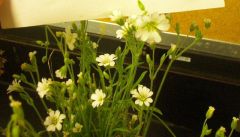
1)Herbaceous, 70gen/2200spp
2)Opposite leaves, swollen nodes 3)Floral parts actinomorphic;in fives; free-central placentation (sometimes basal); 5 sepals, 5 petals (consists of blade & claw), 10 stamens, 2-5 fused superior carpels; no betalain pigments. 4)Fruit-capsule (dehiscent). |
|
|
CARYPHYLLACEAE (Carnation-"Pink family")
|

1)Herbaceous, 70gen/2200spp
2)Opposite leaves, swollen nodes 3)Floral parts actinomorphic;in fives; free-central placentation (sometimes basal); 5 sepals, 5 petals (consists of blade & claw), 10 stamens, 2-5 fused superior carpels; no betalain pigments. 4)Fruit-capsule (dehiscent). |
|
|
CARYOPHYLLACEAE (Carnation-"pink family")
|
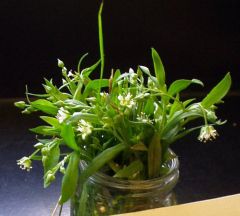
1)Herbaceous, 70gen/2200spp
2)Opposite leaves, swollen nodes 3)Floral parts actinomorphic;in fives; free-central placentation (sometimes basal); 5 sepals, 5 petals (consists of blade & claw), 10 stamens, 2-5 fused superior carpels; no betalain pigments. 4)Fruit-capsule (dehiscent). |
|
|
CARYOPHYLLACEAE (Carnation-"pink family")
|
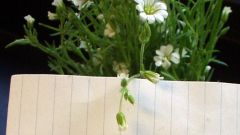
1)Herbaceous, 70gen/2200spp
2)Opposite leaves, swollen nodes 3)Floral parts actinomorphic;in fives; free-central placentation (sometimes basal); 5 sepals, 5 petals (consists of blade & claw), 10 stamens, 2-5 fused carpels; no betalain pigments. 4)Fruit-capsule (dehiscent). |
|
|
CARYOPHYLLACEAE (Carnation-"pink family")
|
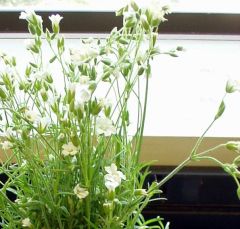
1)Herbaceous, 70gen/2200spp
2)Opposite leaves, swollen nodes 3)Floral parts actinomorphic;in fives; free-central placentation (sometimes basal); 5 sepals, 5 petals (consists of blade & claw), 10 stamens, 2-5 fused superior carpels; no betalain pigments. 4)Fruit-capsule (dehiscent). |
|
|
CARYOHPHYLLACEAE (Carnation-"pink family")
|
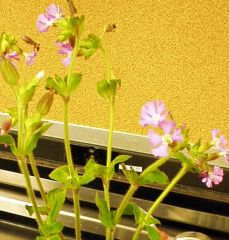
1)Herbaceous, 70gen/2200spp
2)Opposite leaves, swollen nodes 3)Floral parts actinomorphic;in fives; free-central placentation (sometimes basal); 5 sepals, 5 petals (consists of blade & claw), 10 stamens, 2-5 fused superior carpels; no betalain pigments. 4)Fruit-capsule (dehiscent). |
|
|
CARYOHPHYLLACEAE(Carnation-"pink family")
|
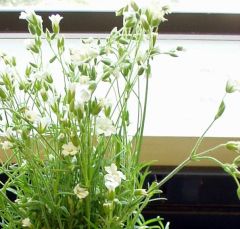
1)Herbaceous, 70gen/2200spp
2)Opposite leaves, swollen nodes 3)Floral parts actinomorphic;in fives; free-central placentation (sometimes basal); 5 sepals, 5 petals (consists of blade & claw), 10 stamens, 2-5 fused superior carpels; no betalain pigments. 4)Fruit-capsule (dehiscent). |
|
|
A group in the tricolpates (and name two groups w/in it) that is characterized by:
1)presence of Betalain pigments(most red or purple)which are nitrogen-containing in this group 2)have free-central (or sometimes basal) placentation 3)have perisperm tissue in the seed (derived from the ovule wall(2n)), as nutritive tissue (although double fertilization does take place). 4)have anomalous secondary growth, multiple vascular cambia. ex: beets. 5)embryo is curved completely around the seed in a tight coil. 6)sieve-tube plastids of "p-type." 7)have succulent thick fleshy tissues 8)halophytes-"salt plants" |
Caryophyllidae:
1)Caryophyllales 2)Polygonales |
|
|
1)All new world (a couple reps in Africa), 90 gen/1400spp
2)Succulent stems 3)Leaves are in form of spines, clusters of them called areoles-lateral buds; the modified leaves themselves are the glochidia (spines). 4)Flowers are actinomorphic; have many tepals and stamens together on a hypanthium; inferior ovary, 3-many fused carpels. 5)Fruit-berry. |
CACTACEAE (Cactus)
|
|
|
PORTULACACEAE (Purslane)
|
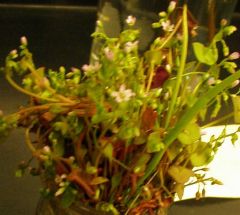
1)Herbaceous, not monophyletic b/c it does not include the cactaceae, 19gen/500spp
2)Leaves simple & alternate, sometimes succulent, most common in fleshy leaves 3)Flowers are actinomorphic, have two bracts that form on both sides called "sepals" although the flowers have 5 (or many) tepals, petals and stamens in fives (or many; 2-3 fused superior carpels. 4)Fruit-capsule |
|
|
PORTULACAECEAE (Purslane)
|
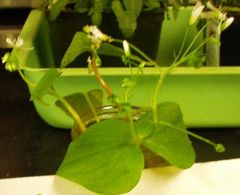
1)Herbaceous, not monophyletic b/c it does not include the cactaceae, 19gen/500spp
2)Leaves simple & alternate, sometimes succulent, most common in fleshy leaves 3)Flowers are actinomorphic, have two bracts that form on both sides called "sepals" although the flowers have 5 (or many) tepals, petals and stamens in fives (or many; 2-3 fused superior carpels. 4)Fruit-capsule |
|
|
PORTULACACEAE (Purslane)
|
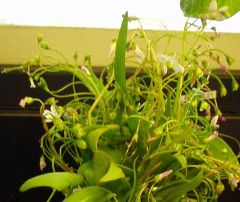
1)Herbaceous, not monophyletic b/c it does not include the cactaceae, 19gen/500spp
2)Leaves simple & alternate, sometimes succulent, most common in fleshy leaves 3)Flowers are actinomorphic, have two bracts that form on both sides called "sepals" although the flowers have 5 (or many) tepals, petals and stamens in fives (or many; 2-3 fused superior carpels. 4)Fruit-capsule |
|
|
POLYGONACEAE (Buckwheat)
|
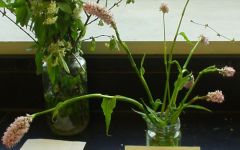
1)Herbs or small shrubs, in tropics may be trees; common in N. America; 40gen/1000spp
2)Leaves simple & alternate 3)Sheathing base made of stipules called "ocrea" 4)Flowers are actinomorphic; parts in 3's; 3 fused superior carpels;no betalains (not part of Caryophyllales) 5)Fruit-achene or nutlet |
|
|
A large group of the tricolpates that includes the Brassicaceae, Malvaceae, Salicaceae, and Violaceae families along with Rosaceae.
|
Rosidae
|
|
|
POLYGONACEAE (Buckwheat)
|
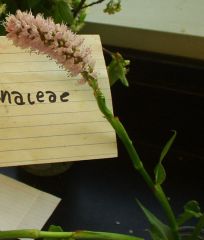
1)Herbs or small shrubs, in tropics may be trees; common in N. America; 40gen/1000spp
2)Leaves simple & alternate 3)Sheathing base made of stipules called "ocrea" 4)Flowers are actinomorphic; parts in 3's; 3 fused superior carpels;no betalains (not part of Caryophyllales) 5)Fruit-achene or nutlet |
|
|
POLYGONACEAE (Buckwheat)
|
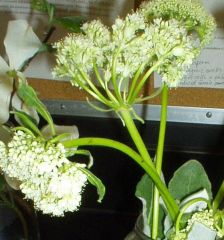
1)Herbs or small shrubs, in tropics may be trees; common in N. America; 40gen/1000spp
2)Leaves simple & alternate 3)Sheathing base made of stipules called "ocrea" 4)Flowers are actinomorphic; parts in 3's; 3 fused superior carpels;no betalains (not part of Caryophyllales) 5)Fruit-achene or nutlet |
|
|
POLYGONACEAE (Buckwheat)
|

1)Herbs or small shrubs, in tropics may be trees; common in N. America; 40gen/1000spp
2)Leaves simple & alternate 3)Sheathing base made of stipules called "ocrea" 4)Flowers are actinomorphic; parts in 3's; 3 fused superior carpels;no betalains (not part of Caryophyllales) 5)Fruit-achene or nutlet |
|
|
POLYGONACEAE (Buckwheat)
|
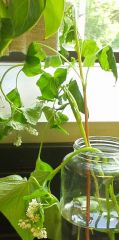
1)Herbs or small shrubs, in tropics may be trees; common in N. America; 40gen/1000spp
2)Leaves simple & alternate 3)Sheathing base made of stipules called "ocrea" 4)Flowers are actinomorphic; parts in 3's; 3 fused superior carpels;no betalains (not part of Caryophyllales) 5)Fruit-achene or nutlet |
|
|
POLYGONACEAE (Buckwheat)
|
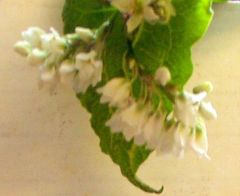
1)Herbs or small shrubs, in tropics may be trees; common in N. America; 40gen/1000spp
2)Leaves simple & alternate 3)Sheathing base made of stipules called "ocrea" 4)Flowers are actinomorphic; parts in 3's; 3 fused superior carpels;no betalains (not part of Caryophyllales) 5)Fruit-achene or nutlet |
|
|
SALICACEAE (Willow)
|
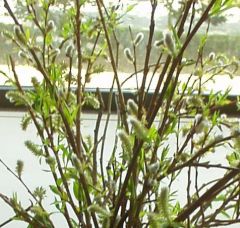
1)2gen/435 spp; Vegetative reproduction performed (w/o use of seeds) by shoots that expand/root out. Branches may drift off into stream and take root along banks.
2)Leaves simmple, have Salicoud teeth, alternate. 3)Flowers are in modified catkins (many small flowers prob w/o petals, sepals); dioecious (sep male and female plants); hairy bract at base of each flower; no perianth;have a nectary that are considered to be a modified calyx; superior ovary, 2-4 fused carpels. 4)Fruit-capsules, hairy seeds that are wind dispersed. |
|
|
SALICACEAE (Willow)
|

1)2gen/435 spp; Vegetative reproduction performed (w/o use of seeds) by shoots that expand/root out. Branches may drift off into stream and take root along banks.
2)Leaves simmple, have Salicoud teeth, alternate. 3)Flowers are in modified catkins (many small flowers prob w/o petals, sepals); dioecious (sep male and female plants); hairy bract at base of each flower; no perianth;have a nectary that are considered to be a modified calyx; superior ovary, 2-4 fused carpels. 4)Fruit-capsules, hairy seeds that are wind dispersed. |
|
|
SALICACEAE (Willow)
|
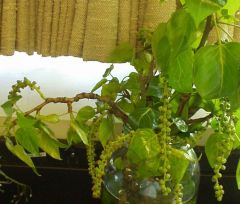
1)2gen/435 spp; Vegetative reproduction performed (w/o use of seeds) by shoots that expand/root out. Branches may drift off into stream and take root along banks.
2)Leaves simmple, have Salicoud teeth, alternate. 3)Flowers are in modified catkins (many small flowers prob w/o petals, sepals); dioecious (sep male and female plants); hairy bract at base of each flower; no perianth;have a nectary that are considered to be a modified calyx; superior ovary, 2-4 fused carpels. 4)Fruit-capsules, hairy seeds that are wind dispersed. |
|
|
VIOLACEAE (Violets)
|
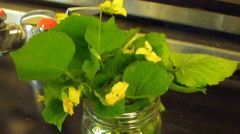
1)Primarly of tropical trees & secondarily of temperate herbs; 22gen/950spp
2)leaves simple, cordate 3)Flower actinomorphic;parts in 5's; 3 fused superior carpels; polypetalous; the open flowers are "chasmogamous," the stamens have a nectary at the base,there is a nectar spur that is part of a petal that shoots back in the oppostite direction; the closed flowers that are always closed self pollinate in the bud and are "cleistogamous." |
|
|
VIOLACEAE (Violet)
|
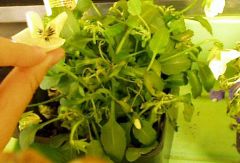
1)Primarly of tropical trees & secondarily of temperate herbs; 22gen/950spp
2)leaves simple, cordate 3)Flower actinomorphic;parts in 5's; 3 fused superior carpels; polypetalous; the open flowers are "chasmogamous," the stamens have a nectary at the base,there is a nectar spur that is part of a petal that shoots back in the oppostite direction; the closed flowers that are always closed self pollinate in the bud and are "cleistogamous." |
|
|
SAXIFRAGACEAE (Saxifrage)
|
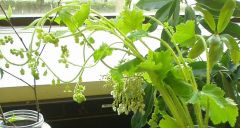
1)All herbaceous;30gen/500spp
2)Leaves tend to be in a basal rosette w/ palmate veination 3)Flowers actinomorphic (some zygomorphic); parts in 5's; carpels partially connate, 2 fused, variance in superiority, tremendous variation b/c of the hypanthium. 4)Fruit-bilocular capsule. |
|
|
SAXIFRAGACEAE (Saxifrage)
|
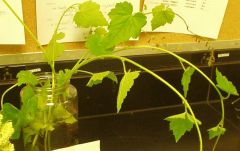
1)All herbaceous;30gen/500spp
2)Leaves tend to be in a basal rosette w/ palmate veination 3)Flowers actinomorphic (some zygomorphic); parts in 5's; carpels partially connate, 2 fused, variance in superiority, tremendous variation b/c of the hypanthium. 4)Fruit-bilocular capsule. |
|
|
SAXIFRACEAE (Saxifrage)
|
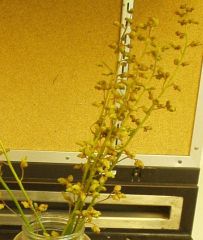
1)All herbaceous;30gen/500spp
2)Leaves tend to be in a basal rosette w/ palmate veination 3)Flowers actinomorphic (some zygomorphic); parts in 5's; carpels partially connate, 2 fused, variance in superiority, tremendous variation b/c of the hypanthium. 4)Fruit-bilocular capsule. |
|
|
SAXIFRAGACEAE (Saxifrage)
|

1)All herbaceous;30gen/500spp
2)Leaves tend to be in a basal rosette w/ palmate veination 3)Flowers actinomorphic (some zygomorphic); parts in 5's; carpels partially connate, 2 fused, variance in superiority, tremendous variation b/c of the hypanthium. 4)Fruit-bilocular capsule. |
|
|
SAXIFRAGACEAE (Saxifrage)
|
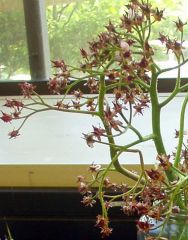
1)All herbaceous;30gen/500spp
2)Leaves tend to be in a basal rosette w/ palmate veination 3)Flowers actinomorphic (some zygomorphic); parts in 5's; carpels partially connate, 2 fused, variance in superiority, tremendous variation b/c of the hypanthium. 4)Fruit-bilocular capsule. |
|
|
SAXIFRAGACEAE (Saxifrage)
|

1)All herbaceous;30gen/500spp
2)Leaves tend to be in a basal rosette w/ palmate veination 3)Flowers actinomorphic (some zygomorphic); parts in 5's; carpels partially connate, 2 fused, variance in superiority, tremendous variation b/c of the hypanthium. 4)Fruit-bilocular capsule. |
|
|
SAXIFRAGACEAE (Saxifrage)
|

1)All herbaceous;30gen/500spp
2)Leaves tend to be in a basal rosette w/ palmate veination 3)Flowers actinomorphic (some zygomorphic); parts in 5's; carpels partially connate, 2 fused, variance in superiority, tremendous variation b/c of the hypanthium. 4)Fruit-bilocular capsule. |
|
|
ACERACEAE (Maple)
|
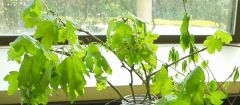
1)many plants originated in tropics and evolved into plants in northern temperate zones; shrubs, woody; 2gen/115spp
2)Opposite leaves 3)Leaves palmately veined, usually lobed 4)Flowers 4-5 parts, nectary disk @ base stamens; monoecious, dioecious, or androdioecious. 5)Fruit-2 fused carpels, schizocarp, winged. |
|
|
ACERACEAE (Maple)
|
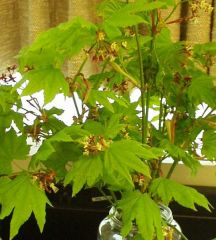
1)many plants originated in tropics and evolved into plants in northern temperate zones; shrubs, woody; 2gen/115spp
2)Opposite leaves 3)Leaves palmately veined, usually lobed 4)Flowers 4-5 parts, nectary disk @ base stamens; monoecious, dioecious, or androdioecious. 5)Fruit-2 fused carpels, schizocarp, winged. |
|
|
ACERACEAE (Maple)
|
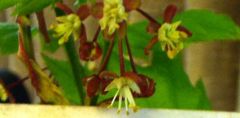
1)many plants originated in tropics and evolved into plants in northern temperate zones; shrubs, woody; 2gen/115spp
2)Opposite leaves 3)Leaves palmately veined, usually lobed 4)Flowers 4-5 parts, nectary disk @ base stamens; monoecious, dioecious, or androdioecious. 5)Fruit-2 fused carpels, schizocarp, winged. |
|
|
BRASSICACEAE/Cruciferae (Mustard)
|
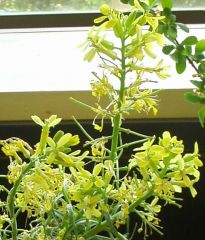
1)Herbs; 400+gen/4000+spp; have glucosinolates
2)Flowers very uniform; calyx/corolla in 4's; stamens 4 long & 2 short "tetradynamous," although the Capparaceae placed inside this family has 6 stamens of equal length; superior ovary, 2 fused carpels. 3)Fruit- some long and slender "silique", some short and wide "silide" both called a "replum" |
|
|
BRASSICACEAE/Cruciferae (Mustard)
|

1)Herbs; 400+gen/4000+spp; have glucosinolates
2)Flowers very uniform; calyx/corolla in 4's; stamens 4 long & 2 short "tetradynamous," although the Capparaceae placed inside this family has 6 stamens of equal length; superior ovary, 2 fused carpels. 3)Fruit- some long and slender "silique", some short and wide "silide" both called a "replum" |
|
|
BRASSICACEAE/Cruciferae (Mustard)
|
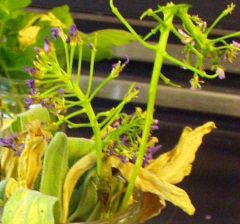
1)Herbs; 400+gen/4000+spp; have glucosinolates
2)Flowers very uniform; calyx/corolla in 4's; stamens 4 long & 2 short "tetradynamous," although the Capparaceae placed inside this family has 6 stamens of equal length; superior ovary, 2 fused carpels. 3)Fruit- some long and slender "silique", some short and wide "silide" both called a "replum" |
|
|
BRASSICACEAE/Cruciferae (Mustard)
|

1)Herbs; 400+gen/4000+spp; have glucosinolates
2)Flowers very uniform; calyx/corolla in 4's; stamens 4 long & 2 short "tetradynamous," although the Capparaceae placed inside this family has 6 stamens of equal length; superior ovary, 2 fused carpels. 3)Fruit- some long and slender "silique", some short and wide "silide" both called a "replum" |
|
|
BRASSICACEAE/Cruciferae (Mustard)
|

1)Herbs; 400+gen/4000+spp; have glucosinolates
2)Flowers very uniform; calyx/corolla in 4's; stamens 4 long & 2 short "tetradynamous," although the Capparaceae placed inside this family has 6 stamens of equal length; superior ovary, 2 fused carpels. 3)Fruit- some long and slender "silique", some short and wide "silide" both called a "replum" |
|
|
BRASSICACEAE/Cruciferae (Mustard)
|
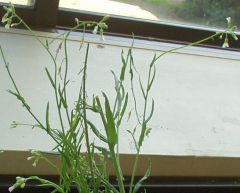
1)Herbs; 400+gen/4000+spp; have glucosinolates
2)Flowers very uniform; calyx/corolla in 4's; stamens 4 long & 2 short "tetradynamous," although the Capparaceae placed inside this family has 6 stamens of equal length; superior ovary, 2 fused carpels. 3)Fruit- some long and slender "silique", some short and wide "silide" both called a "replum" |
|
|
BRASSICACEAE/Cruciferae (Mustard)
|

1)Herbs; 400+gen/4000+spp; have glucosinolates
2)Flowers very uniform; calyx/corolla in 4's; stamens 4 long & 2 short "tetradynamous," although the Capparaceae placed inside this family has 6 stamens of equal length; superior ovary, 2 fused carpels. 3)Fruit- some long and slender "silique", some short and wide "silide" both called a "replum" |
|
|
ONAGRACEAE (Evening Primrose)
|
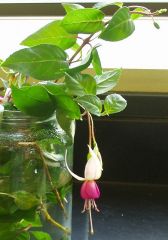
1)Herbs;mostly in N. America
2)Leaves alternate & opposite & whorled. 3)Flowers 4 parted; inferior ovary; anthers versatile with the pollen in tetrads and viscin holding it together; 4 carpels 4)Fruit-capsule |
|
|
MALVACEAE (Mallow)
|
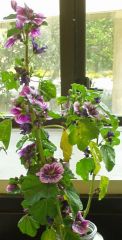
1)Most herbs; 200gen/2000spp; stellate/branched hairs
2)Leaves palmately lobed/veined 3)Flowers 5 parted perianth; stamens many (sometimes 5), monodelphous; 5 fused superior carpels 4)Fruit-capsule |
|
|
MALVACEAE (Mallow)
|

1)Most herbs; 200gen/2000spp; stellate/branched hairs
2)Leaves palmately lobed/veined 3)Flowers 5 parted perianth; stamens many (sometimes 5), monodelphous; 5 fused superior carpels 4)Fruit-capsule |
|
|
MALVACEAE (Mallow)
|
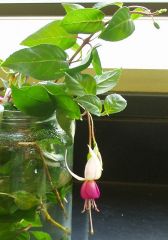
1)Most herbs; 200gen/2000spp; stellate/branched hairs
2)Leaves palmately lobed/veined 3)Flowers 5 parted perianth; stamens many (sometimes 5), monodelphous; 5 fused superior carpels 4)Fruit-capsule |
|
|
MALVACEAE (Mallow)
|
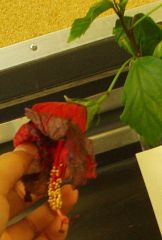
1)Most herbs; 200gen/2000spp; stellate/branched hairs
2)Leaves palmately lobed/veined 3)Flowers 5 parted perianth; stamens many (sometimes 5), monodelphous; 5 fused superior carpels 4)Fruit-capsule |
|
|
GERANIACEAE (Geranium)
|
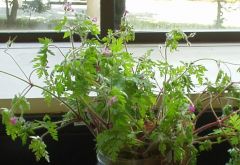
1)Herbs to subshrubs; hairs simple, glandular; 7gen/750spp
2)Leaves palmately veined, alt or opp, simple, lobed or compound 3)Flowers bisexual, actinomorphic or bilateral; 5 parted perianth; stamens 10-15; 5 fused superior connate carpels(long-beaked), axile placentation, sterile column in center that elongates after fertilization, 1 style, ovules 2 per locule 4)Fruit-schizocarp w/ 5 one-seeded segments |
|
|
GERANIACEAE (Geranium)
|

1)Herbs to subshrubs; hairs simple, glandular; 7gen/750spp
2)Leaves palmately veined, alt or opp, simple, lobed or compound 3)Flowers bisexual, actinomorphic or bilateral; 5 parted perianth; stamens 10-15; 5 fused superior connate carpels(long-beaked), axile placentation, sterile column in center that elongates after fertilization, 1 style, ovules 2 per locule 4)Fruit-schizocarp w/ 5 one-seeded segments |
|
|
GERANIACEAE (Geranium)
|

1)Herbs to subshrubs; hairs simple, glandular; 7gen/750spp
2)Leaves palmately veined, alt or opp, simple, lobed or compound 3)Flowers bisexual, actinomorphic or bilateral; 5 parted perianth; stamens 10-15; 5 fused superior connate carpels(long-beaked), axile placentation, sterile column in center that elongates after fertilization, 1 style, ovules 2 per locule 4)Fruit-schizocarp w/ 5 one-seeded segments |
|
|
GERANIACEAE (Geranium)
|
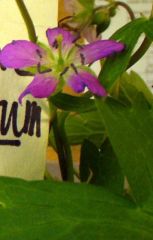
1)Herbs to subshrubs; hairs simple, glandular; 7gen/750spp
2)Leaves palmately veined, alt or opp, simple, lobed or compound 3)Flowers bisexual, actinomorphic or bilateral; 5 parted perianth; stamens 10-15; 5 fused superior connate carpels(long-beaked), axile placentation, sterile column in center that elongates after fertilization, 1 style, ovules 2 per locule 4)Fruit-schizocarp w/ 5 one-seeded segments |
|
|
GERANIACEAE (Geranium)
|
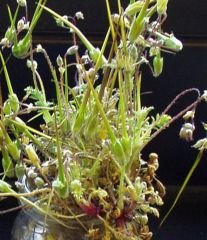
1)Herbs to subshrubs; hairs simple, glandular; 7gen/750spp
2)Leaves palmately veined, alt or opp, simple, lobed or compound 3)Flowers bisexual, actinomorphic or bilateral; 5 parted perianth; stamens 10-15; 5 fused superior connate carpels(long-beaked), axile placentation, sterile column in center that elongates after fertilization, 1 style, ovules 2 per locule 4)Fruit-schizocarp w/ 5 one-seeded segments |
|
|
ROSACEAE (Rose)
|
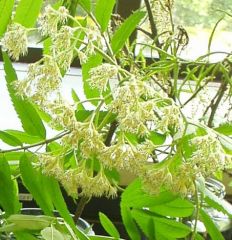
1)Woody or herbaceous; 95gen/3000spp
2)Leaves usually pinnately compound, sometimes simple, serrate, alternate; stipules which are evident in herbs. 3)Flowers actinomorphic; uniform, almost always a hypanthium; 5 sepals & petals; 1-many fused carpels (varying superiority); stamens many; 4)Fruit-follicle, capsule, achene or druplet, drupes, or pome. |
|
|
ROSACEAE (Rose)
|
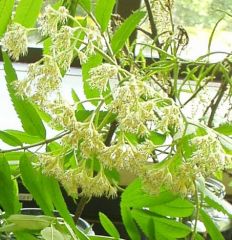
1)Woody or herbaceous; 95gen/3000spp
2)Leaves usually pinnately compound, sometimes simple, serrate, alternate; stipules which are evident in herbs. 3)Flowers actinomorphic; uniform, almost always a hypanthium; 5 sepals & petals; 1-many fused carpels (varying superiority); stamens many; 4)Fruit-follicle, capsule, achene or druplet, drupes, or pome. |
|
|
ROSACEAE (Rose)
|

1)Woody or herbaceous; 95gen/3000spp
2)Leaves usually pinnately compound, sometimes simple, serrate, alternate; stipules which are evident in herbs. 3)Flowers actinomorphic; uniform, almost always a hypanthium; 5 sepals & petals; 1-many fused carpels (varying superiority); stamens many; 4)Fruit-follicle, capsule, achene or druplet, drupes, or pome. |
|
|
ROSACEAE (Rose)
|
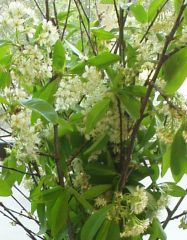
1)Woody or herbaceous; 95gen/3000spp
2)Leaves usually pinnately compound, sometimes simple, serrate, alternate; stipules which are evident in herbs. 3)Flowers actinomorphic; uniform, almost always a hypanthium; 5 sepals & petals; 1-many fused carpels (varying superiority); stamens many; 4)Fruit-follicle, capsule, achene or druplet, drupes, or pome. |
|
|
ROSACEAE (Rose)
|
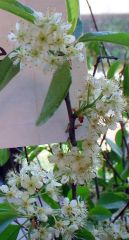
1)Woody or herbaceous; 95gen/3000spp
2)Leaves usually pinnately compound, sometimes simple, serrate, alternate; stipules which are evident in herbs. 3)Flowers actinomorphic; uniform, almost always a hypanthium; 5 sepals & petals; 1-many fused carpels (varying superiority); stamens many; 4)Fruit-follicle, capsule, achene or druplet, drupes, or pome. |
|
|
ROSACEAE (Rose)
|
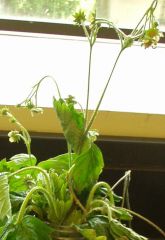
1)Woody or herbaceous; 95gen/3000spp
2)Leaves usually pinnately compound, sometimes simple, serrate, alternate; stipules which are evident in herbs. 3)Flowers actinomorphic; uniform, almost always a hypanthium; 5 sepals & petals; 1-many fused carpels (varying superiority); stamens many; 4)Fruit-follicle, capsule, achene or druplet, drupes, or pome. |
|
|
ROSACEAE (Rose)
|
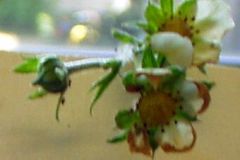
1)Woody or herbaceous; 95gen/3000spp
2)Leaves usually pinnately compound, sometimes simple, serrate, alternate; stipules which are evident in herbs. 3)Flowers actinomorphic; uniform, almost always a hypanthium; 5 sepals & petals; 1-many fused carpels (varying superiority); stamens many; 4)Fruit-follicle, capsule, achene or druplet, drupes, or pome. |
|
|
ROSACEAE (Rose)
|

1)Woody or herbaceous; 95gen/3000spp
2)Leaves usually pinnately compound, sometimes simple, serrate, alternate; stipules which are evident in herbs. 3)Flowers actinomorphic; uniform, almost always a hypanthium; 5 sepals & petals; 1-many fused carpels (varying superiority); stamens many; 4)Fruit-follicle, capsule, achene or druplet, drupes, or pome. |
|
|
FABACEAE/LEGUMINOSAE (Pea)
|

1)Mostly tropical trees, desert trees/shrubs, temperate zones, herbs; nitrogen fixing bacteria in symbiotic rltnship; 650gen/18,000spp
2)Leaves usually pinnately or palmately compound, entire, have stipules 3)Flowers typically zygomorphic; perianth parts typically in 5's; 10-many stamens; one superior carpel; papillionoideae "flag flower" is bilateral and has 9+1 stamen (diadelphous) where the lower petals (the keel) are connate and there are also wing and banner petals; Caesalpinoideae is like the flag flowers but the keel is not fused and all 10 stamens are unfused; mimosoideae-"brush flowers", actinomorphic, many stamens, stigmas much extended and tiny corolla. |
|
|
FABACEAE/LEGUMINOSAE (Pea)
|

1)Mostly tropical trees, desert trees/shrubs, temperate zones, herbs; nitrogen fixing bacteria in symbiotic rltnship; 650gen/18,000spp
2)Leaves usually pinnately or palmately compound, entire, have stipules 3)Flowers typically zygomorphic; perianth parts typically in 5's; 10-many stamens; one superior carpel; papillionoideae "flag flower" is bilateral and has 9+1 stamen (diadelphous) where the lower petals (the keel) are connate and there are also wing and banner petals; Caesalpinoideae is like the flag flowers but the keel is not fused and all 10 stamens are unfused; mimosoideae-"brush flowers", actinomorphic, many stamens, stigmas much extended and tiny corolla. |
|
|
FABACEAE/LEGUMINOSAE (Pea)
|
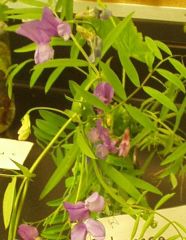
1)Mostly tropical trees, desert trees/shrubs, temperate zones, herbs; nitrogen fixing bacteria in symbiotic rltnship; 650gen/18,000spp
2)Leaves usually pinnately or palmately compound, entire, have stipules 3)Flowers typically zygomorphic; perianth parts typically in 5's; 10-many stamens; one superior carpel; papillionoideae "flag flower" is bilateral and has 9+1 stamen (diadelphous) where the lower petals (the keel) are connate and there are also wing and banner petals; Caesalpinoideae is like the flag flowers but the keel is not fused and all 10 stamens are unfused; mimosoideae-"brush flowers", actinomorphic, many stamens, stigmas much extended and tiny corolla. |
|
|
FABACEAE/LEGUMINOSAE (Pea)
|
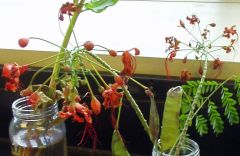
1)Mostly tropical trees, desert trees/shrubs, temperate zones, herbs; nitrogen fixing bacteria in symbiotic rltnship; 650gen/18,000spp
2)Leaves usually pinnately or palmately compound, entire, have stipules 3)Flowers typically zygomorphic; perianth parts typically in 5's; 10-many stamens; one superior carpel; papillionoideae "flag flower" is bilateral and has 9+1 stamen (diadelphous) where the lower petals (the keel) are connate and there are also wing and banner petals; Caesalpinoideae is like the flag flowers but the keel is not fused and all 10 stamens are unfused; mimosoideae-"brush flowers", actinomorphic, many stamens, stigmas much extended and tiny corolla. |
|
|
FABACEAE/LEGUMINOSAE (Pea)
|

1)Mostly tropical trees, desert trees/shrubs, temperate zones, herbs; nitrogen fixing bacteria in symbiotic rltnship; 650gen/18,000spp
2)Leaves usually pinnately or palmately compound, entire, have stipules 3)Flowers typically zygomorphic; perianth parts typically in 5's; 10-many stamens; one superior carpel; papillionoideae "flag flower" is bilateral and has 9+1 stamen (diadelphous) where the lower petals (the keel) are connate and there are also wing and banner petals; Caesalpinoideae is like the flag flowers but the keel is not fused and all 10 stamens are unfused; mimosoideae-"brush flowers", actinomorphic, many stamens, stigmas much extended and tiny corolla. |
|
|
EUPHORBIACEAE (Spurge)
|
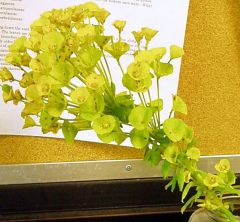
1)Herbs, shrubs, trees or succulent like cacti; milky latex->dermatitis;
2)Leavesthe spines dont sit in groups of glochids like cacti 3)Flowers are reduced, actinomorphic, unisexual; infloresence =fals flower (pseudanthium); stamens 1-many; carpels 3 fused, 3-lobed superior ovary, axile placentation, 3 styles, entire or bifid to several times divided, ovules 1-2 per locule 4)Fruit-schizocarp into 3 segments |
|
|
EUPHORBIACEAE (Spurge)
|

1)Herbs, shrubs, trees or succulent like cacti; milky latex->dermatitis;
2)Leavesthe spines dont sit in groups of glochids like cacti 3)Flowers are reduced, actinomorphic, unisexual; infloresence =fals flower (pseudanthium); stamens 1-many; carpels 3 fused, 3-lobed superior ovary, axile placentation, 3 styles, entire or bifid to several times divided, ovules 1-2 per locule 4)Fruit-schizocarp into 3 segments |
|
|
EUPHORBIACEAE (Spurge)
|

1)Herbs, shrubs, trees or succulent like cacti; milky latex->dermatitis;
2)Leavesthe spines dont sit in groups of glochids like cacti 3)Flowers are reduced, actinomorphic, unisexual; infloresence =fals flower (pseudanthium); stamens 1-many; carpels 3 fused, 3-lobed superior ovary, axile placentation, 3 styles, entire or bifid to several times divided, ovules 1-2 per locule 4)Fruit-schizocarp into 3 segments |
|
|
ERICACEAE (Heather)
|
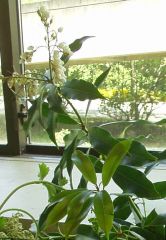
1)Mostly shrubs, some trees and herbs, mycotrophic (aform of parasitism); 130gen/2700spp
2)Leaves mostly simple and often tough and leathery, some "evergreen" 3)Flwers actinomorphic (some zygomorphic); perianth 5-parted; stamens usually 10 & poricidal dehiscence; usually urn-shaped and have buzz pollination; usually 3-5 fused. 4)Fruits-berries, capsules |
|
|
ERICACEAE (Heather)
|

1)Mostly shrubs, some trees and herbs, mycotrophic (aform of parasitism); 130gen/2700spp
2)Leaves mostly simple and often tough and leathery, some "evergreen" 3)Flwers actinomorphic (some zygomorphic); perianth 5-parted; stamens usually 10 & poricidal dehiscence; usually urn-shaped and have buzz pollination; usually 3-5 fused. 4)Fruits-berries, capsules |
|
|
ERICACEAE (Heather)
|
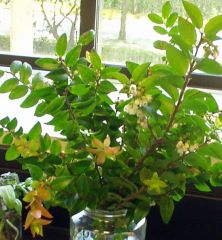
1)Mostly shrubs, some trees and herbs, mycotrophic (aform of parasitism); 130gen/2700spp
2)Leaves mostly simple and often tough and leathery, some "evergreen" 3)Flwers actinomorphic (some zygomorphic); perianth 5-parted; stamens usually 10 & poricidal dehiscence; usually urn-shaped and have buzz pollination; usually 3-5 fused. 4)Fruits-berries, capsules |
|
|
ERICACEAE (Heather)
|
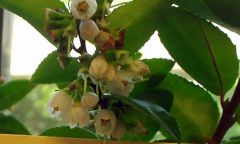
1)Mostly shrubs, some trees and herbs, mycotrophic (aform of parasitism); 130gen/2700spp
2)Leaves mostly simple and often tough and leathery, some "evergreen" 3)Flwers actinomorphic (some zygomorphic); perianth 5-parted; stamens usually 10 & poricidal dehiscence; usually urn-shaped and have buzz pollination; usually 3-5 fused. 4)Fruits-berries, capsules |
|
|
ERICACEAE (Heather)
|
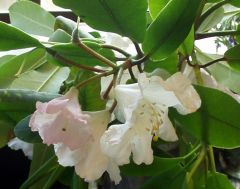
1)Mostly shrubs, some trees and herbs, mycotrophic (aform of parasitism); 130gen/2700spp
2)Leaves mostly simple and often tough and leathery, some "evergreen" 3)Flwers actinomorphic (some zygomorphic); perianth 5-parted; stamens usually 10 & poricidal dehiscence; usually urn-shaped and have buzz pollination; usually 3-5 fused. 4)Fruits-berries, capsules |
|
|
POLEMONIACEAE (Phlox)
|
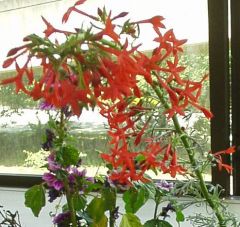
1)Mostly in N. America, some in S.; almost all herbs; 16gen/320spp
2)Leaves simple and alternate typically, sometimes opp &/or dissected. 3)Flowers 5parted, and the 5 stamens alternate w/ petals, unequal insertion of stamens in the epipetalous arrangement; 3 fused carpels with 3 styles; translucent membrane that connects tubing in calyx 4)Fruit-typically a capsule |
|
|
POLEMONIACEAE (Phlox)
|
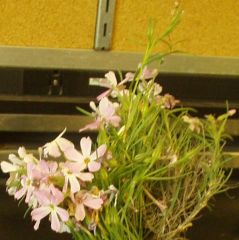
1)Mostly in N. America, some in S.; almost all herbs; 16gen/320spp
2)Leaves simple and alternate typically, sometimes opp &/or dissected. 3)Flowers 5parted, and the 5 stamens alternate w/ petals, unequal insertion of stamens in the epipetalous arrangement; 3 fused carpels with 3 styles; translucent membrane that connects tubing in calyx 4)Fruit-typically a capsule |
|
|
POLEMONIACEAE (Phlox)
|
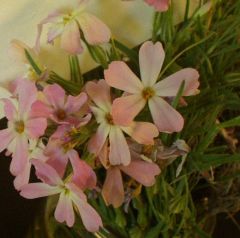
1)Mostly in N. America, some in S.; almost all herbs; 16gen/320spp
2)Leaves simple and alternate typically, sometimes opp &/or dissected. 3)Flowers 5parted, and the 5 stamens alternate w/ petals, unequal insertion of stamens in the epipetalous arrangement; 3 fused carpels with 3 styles; translucent membrane that connects tubing in calyx 4)Fruit-typically a capsule |
|
|
POLEMONIACEAE (Phlox)
|
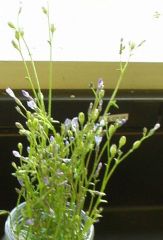
1)Mostly in N. America, some in S.; almost all herbs; 16gen/320spp
2)Leaves simple and alternate typically, sometimes opp &/or dissected. 3)Flowers 5parted, and the 5 stamens alternate w/ petals, unequal insertion of stamens in the epipetalous arrangement; 3 fused carpels with 3 styles; translucent membrane that connects tubing in calyx 4)Fruit-typically a capsule |
|
|
POLEMONIACEAE (Phlox)
|
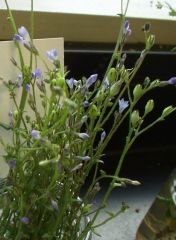
1)Mostly in N. America, some in S.; almost all herbs; 16gen/320spp
2)Leaves simple and alternate typically, sometimes opp &/or dissected. 3)Flowers 5parted, and the 5 stamens alternate w/ petals, unequal insertion of stamens in the epipetalous arrangement; 3 fused carpels with 3 styles; translucent membrane that connects tubing in calyx 4)Fruit-typically a capsule |
|
|
CORNACEAE (Dogwood)
|
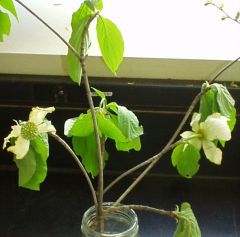
1)trees or shrubs
2)Leaves opp & simple (rarely alt); secondary veins arching from base to tip 3)Flowers in infloresence terminal w/ enlarged showy bracts; sepals and petals 4; ovary inferior |
|
|
CORNACEAE (Dogwood)
|
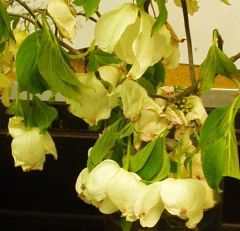
1)trees or shrubs
2)Leaves opp & simple (rarely alt); secondary veins arching from base to tip 3)Flowers in infloresence terminal w/ enlarged showy bracts; sepals and petals 4; ovary inferior |
|
|
CORNACEAE (Dogwood)
|
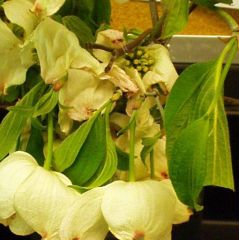
1)trees or shrubs
2)Leaves opp & simple (rarely alt); secondary veins arching from base to tip 3)Flowers in infloresence terminal w/ enlarged showy bracts; sepals and petals 4; ovary inferior |
|
|
CORNACEAE (Dogwood)
|

1)trees or shrubs
2)Leaves opp & simple (rarely alt); secondary veins arching from base to tip 3)Flowers in infloresence terminal w/ enlarged showy bracts; sepals and petals 4; ovary inferior |
|
|
CORNACEAE (Dogwood)
|
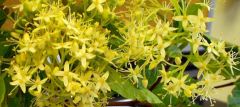
1)trees or shrubs
2)Leaves opp & simple (rarely alt); secondary veins arching from base to tip 3)Flowers in infloresence terminal w/ enlarged showy bracts; sepals and petals 4; ovary inferior |
|
|
CORNACEAE (Dogwood)
|
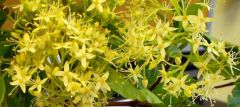
1)trees or shrubs
2)Leaves opp & simple (rarely alt); secondary veins arching from base to tip 3)Flowers in infloresence terminal w/ enlarged showy bracts; sepals and petals 4; ovary inferior |
|
|
BORAGINACEAE (Forget-me-not)
|
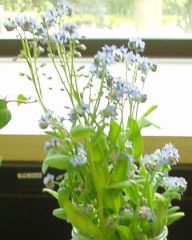
1)mostly herbaceous, in tropics, woody and trees and shrubs; 134gen/2650spp
2)leaves covered in hispid hairs (stiff & prickly), mostly simple (sometimes deeply divided) 3)Infloresence consists of a coil that uncoils as it opens, there is the "scorpioid cyme" (alt sort of branching) and the one sided coil. 4)corollas often have a 'corona'; inserted or exerted stamens; two style and one lobe or one style and 'four' lobes (w/ false septum) |
|
|
BORAGINACEAE (Forget-me-not)
|
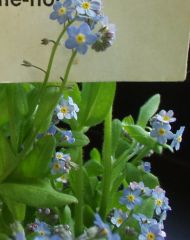
1)mostly herbaceous, in tropics, woody and trees and shrubs; 134gen/2650spp
2)leaves covered in hispid hairs (stiff & prickly), mostly simple (sometimes deeply divided) 3)Infloresence consists of a coil that uncoils as it opens, there is the "scorpioid cyme" (alt sort of branching) and the one sided coil. 4)corollas often have a 'corona'; inserted or exerted stamens; two style and one lobe or one style and 'four' lobes (w/ false septum) |
|
|
BORAGINACEAE (Forget-me-not)
|
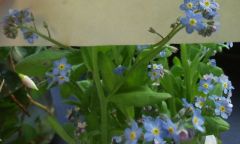
1)mostly herbaceous, in tropics, woody and trees and shrubs; 134gen/2650spp
2)leaves covered in hispid hairs (stiff & prickly), mostly simple (sometimes deeply divided) 3)Infloresence consists of a coil that uncoils as it opens, there is the "scorpioid cyme" (alt sort of branching) and the one sided coil. 4)corollas often have a 'corona'; inserted or exerted stamens; two style and one lobe or one style and 'four' lobes (w/ false septum) |
|
|
BORAGINACEAE (Forget-me-not)
|
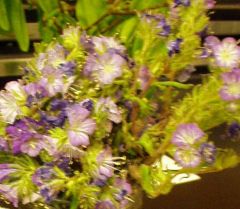
1)mostly herbaceous, in tropics, woody and trees and shrubs; 134gen/2650spp
2)leaves covered in hispid hairs (stiff & prickly), mostly simple (sometimes deeply divided) 3)Infloresence consists of a coil that uncoils as it opens, there is the "scorpioid cyme" (alt sort of branching) and the one sided coil. 4)corollas often have a 'corona'; inserted or exerted stamens; two style and one lobe or one style and 'four' lobes (w/ false septum) |
|
|
BORAGINACEAE (Forget-me-not)
|
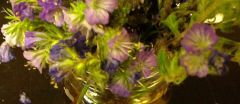
1)mostly herbaceous, in tropics, woody and trees and shrubs; 134gen/2650spp
2)leaves covered in hispid hairs (stiff & prickly), mostly simple (sometimes deeply divided) 3)Infloresence consists of a coil that uncoils as it opens, there is the "scorpioid cyme" (alt sort of branching) and the one sided coil. 4)corollas often have a 'corona'; inserted or exerted stamens; two style and one lobe or one style and 'four' lobes (w/ false septum) |
|
|
BORAGINACEAE (Forget-me-not)
|
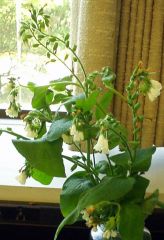
1)mostly herbaceous, in tropics, woody and trees and shrubs; 134gen/2650spp
2)leaves covered in hispid hairs (stiff & prickly), mostly simple (sometimes deeply divided) 3)Infloresence consists of a coil that uncoils as it opens, there is the "scorpioid cyme" (alt sort of branching) and the one sided coil. 4)corollas often have a 'corona'; inserted or exerted stamens; two style and one lobe or one style and 'four' lobes (w/ false septum) |
|
|
BORAGINACEAE (Forget-me-not)
|
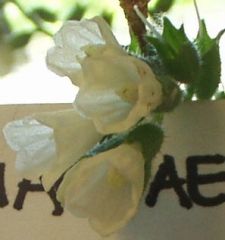
1)mostly herbaceous, in tropics, woody and trees and shrubs; 134gen/2650spp
2)leaves covered in hispid hairs (stiff & prickly), mostly simple (sometimes deeply divided) 3)Infloresence consists of a coil that uncoils as it opens, there is the "scorpioid cyme" (alt sort of branching) and the one sided coil. 4)corollas often have a 'corona'; inserted or exerted stamens; two style and one lobe or one style and 'four' lobes (w/ false septum) |
|
|
BORAGINACEAE (Forget-me-not)
|

1)mostly herbaceous, in tropics, woody and trees and shrubs; 134gen/2650spp
2)leaves covered in hispid hairs (stiff & prickly), mostly simple (sometimes deeply divided) 3)Infloresence consists of a coil that uncoils as it opens, there is the "scorpioid cyme" (alt sort of branching) and the one sided coil. 4)corollas often have a 'corona'; inserted or exerted stamens; two style and one lobe or one style and 'four' lobes (w/ false septum) |
|
|
BORAGINACEAE (Forget-me-not)
|
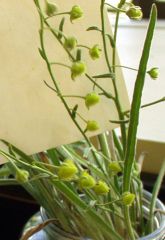
1)mostly herbaceous, in tropics, woody and trees and shrubs; 134gen/2650spp
2)leaves covered in hispid hairs (stiff & prickly), mostly simple (sometimes deeply divided) 3)Infloresence consists of a coil that uncoils as it opens, there is the "scorpioid cyme" (alt sort of branching) and the one sided coil. 4)corollas often have a 'corona'; inserted or exerted stamens; two style and one lobe or one style and 'four' lobes (w/ false septum) |
|
|
BORAGINACEAE (Forget-me-not)
|
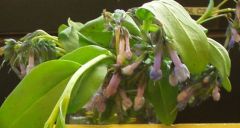
1)mostly herbaceous, in tropics, woody and trees and shrubs; 134gen/2650spp
2)leaves covered in hispid hairs (stiff & prickly), mostly simple (sometimes deeply divided) 3)Infloresence consists of a coil that uncoils as it opens, there is the "scorpioid cyme" (alt sort of branching) and the one sided coil. 4)corollas often have a 'corona'; inserted or exerted stamens; two style and one lobe or one style and 'four' lobes (w/ false septum) |
|
|
BORAGINACEAE (Forget-me-not)
|
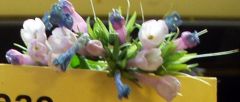
1)mostly herbaceous, in tropics, woody and trees and shrubs; 134gen/2650spp
2)leaves covered in hispid hairs (stiff & prickly), mostly simple (sometimes deeply divided) 3)Infloresence consists of a coil that uncoils as it opens, there is the "scorpioid cyme" (alt sort of branching) and the one sided coil. 4)corollas often have a 'corona'; inserted or exerted stamens; two style and one lobe or one style and 'four' lobes (w/ false septum) |
|
|
BORAGINACEAE (Forget-me-not)
|

1)mostly herbaceous, in tropics, woody and trees and shrubs; 134gen/2650spp
2)leaves covered in hispid hairs (stiff & prickly), mostly simple (sometimes deeply divided) 3)Infloresence consists of a coil that uncoils as it opens, there is the "scorpioid cyme" (alt sort of branching) and the one sided coil. 4)corollas often have a 'corona'; inserted or exerted stamens; two style and one lobe or one style and 'four' lobes (w/ false septum) |
|
|
BORAGINACEAE (Forget-me-not)
|
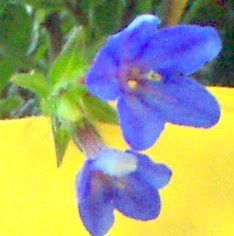
1)mostly herbaceous, in tropics, woody and trees and shrubs; 134gen/2650spp
2)leaves covered in hispid hairs (stiff & prickly), mostly simple (sometimes deeply divided) 3)Infloresence consists of a coil that uncoils as it opens, there is the "scorpioid cyme" (alt sort of branching) and the one sided coil. 4)corollas often have a 'corona'; inserted or exerted stamens; two style and one lobe or one style and 'four' lobes (w/ false septum) |
|
|
BORAGINACEAE (Forget-me-not)
|
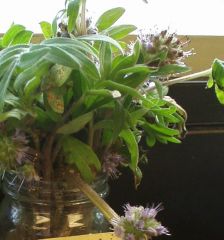
1)mostly herbaceous, in tropics, woody and trees and shrubs; 134gen/2650spp
2)leaves covered in hispid hairs (stiff & prickly), mostly simple (sometimes deeply divided) 3)Infloresence consists of a coil that uncoils as it opens, there is the "scorpioid cyme" (alt sort of branching) and the one sided coil. 4)corollas often have a 'corona'; inserted or exerted stamens; two style and one lobe or one style and 'four' lobes (w/ false septum) |
|
|
BORAGINACEAE (Forget-me-not)
|
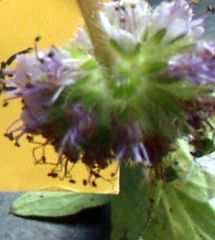
1)mostly herbaceous, in tropics, woody and trees and shrubs; 134gen/2650spp
2)leaves covered in hispid hairs (stiff & prickly), mostly simple (sometimes deeply divided) 3)Infloresence consists of a coil that uncoils as it opens, there is the "scorpioid cyme" (alt sort of branching) and the one sided coil. 4)corollas often have a 'corona'; inserted or exerted stamens; two style and one lobe or one style and 'four' lobes (w/ false septum) |
|
|
SOLANACEAE (Nightshade)
|
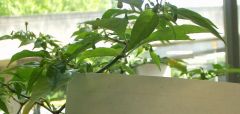
1)mostly herbaceous; have alkaloids
2)Leaves alt, simple (some deeply divided) 3)Flowers actinomorphic(sometimes zygomorphic); anthers not exserted; stigma is capitate; 2 fused carpels with many ovules 4)Fruits-berries or capsules |
|
|
SOLANACEAE (Nightshade)
|

1)mostly herbaceous; have alkaloids
2)Leaves alt, simple (some deeply divided) 3)Flowers actinomorphic(sometimes zygomorphic); anthers not exserted; stigma is capitate; 2 fused carpels with many ovules 4)Fruits-berries or capsules |
|
|
SOLANACEAE (Nightshade)
|
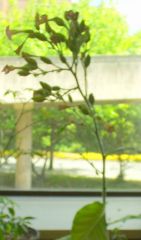
1)mostly herbaceous; have alkaloids
2)Leaves alt, simple (some deeply divided) 3)Flowers actinomorphic(sometimes zygomorphic); anthers not exserted; stigma is capitate; 2 fused carpels with many ovules 4)Fruits-berries or capsules |
|
|
SOLANACEAE (Nightshade)
|

1)mostly herbaceous; have alkaloids
2)Leaves alt, simple (some deeply divided) 3)Flowers actinomorphic(sometimes zygomorphic); anthers not exserted; stigma is capitate; 2 fused carpels with many ovules 4)Fruits-berries or capsules |
|
|
SOLANACEAE (Nightshade)
|
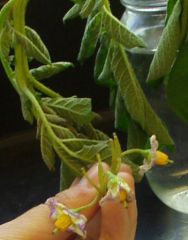
1)mostly herbaceous; have alkaloids
2)Leaves alt, simple (some deeply divided) 3)Flowers actinomorphic(sometimes zygomorphic); anthers not exserted; stigma is capitate; 2 fused carpels with many ovules 4)Fruits-berries or capsules |
|
|
APOCYNACEAE
|
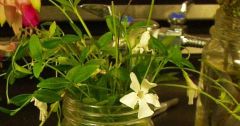
1)milky juice
2)leaves generally opposite 3)Flowers are often with a corona; anthers highly modified and fused to "stigma"=gynostegium w/ "pollinia"; 2 distinct carpels @ base but styles fused at top |
|
|
APOCYNACEAE
|
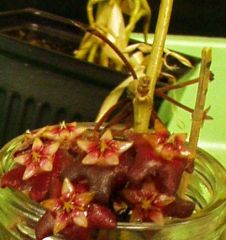
1)milky juice
2)leaves generally opposite 3)Flowers are often with a corona; anthers highly modified and fused to "stigma"=gynostegium w/ "pollinia"; 2 distinct carpels @ base but styles fused at top |
|
|
APOCYNACEAE
|
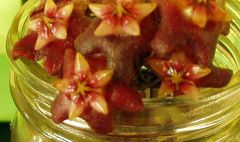
1)milky juice
2)leaves generally opposite 3)Flowers are often with a corona; anthers highly modified and fused to "stigma"=gynostegium w/ "pollinia"; 2 distinct carpels @ base but styles fused at top |

